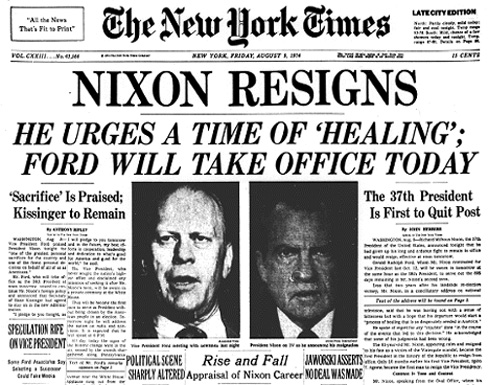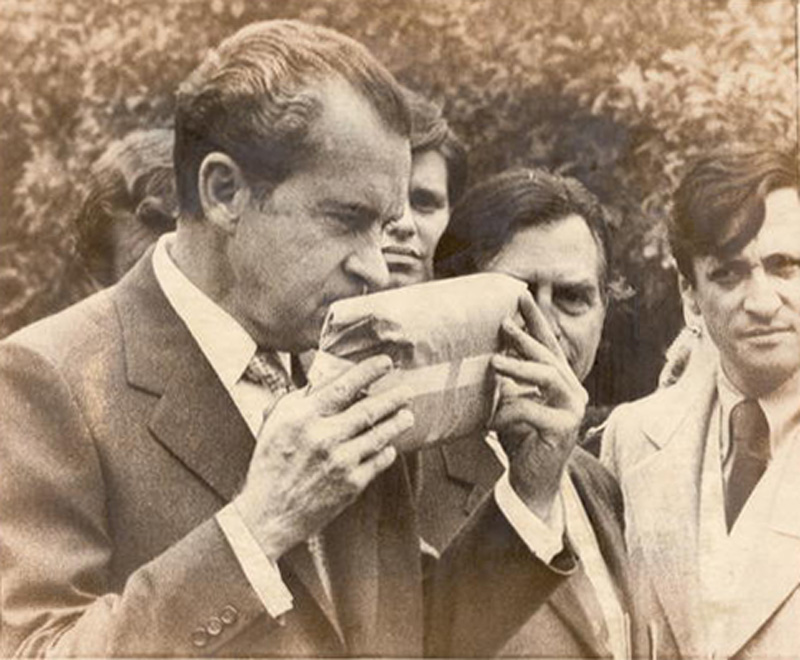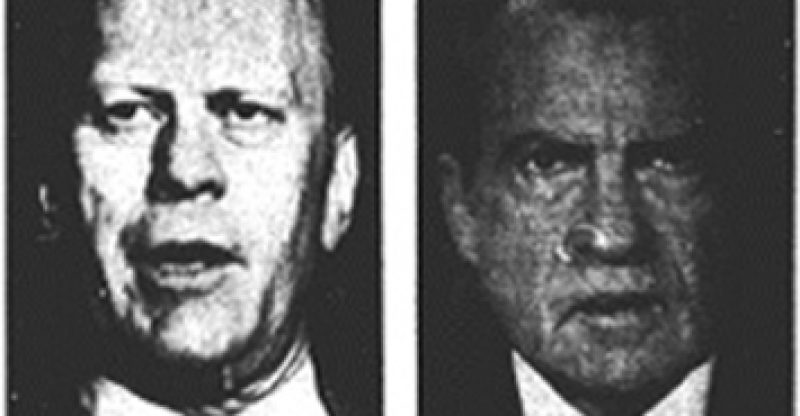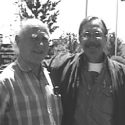Allegations regarding “Butch” Merritt, Watergate, Intelligence Agencies and “Crimson Rose,” Vol. VII
The Dynamics of Sophistication –Part Two
Written (and first posted) by Kris Millegan, March 22, 2011
Lord, you know, everybody they tells me
That somebody done hoodooed the hoodoo man. — Junior Wells
I’d like to state some reasons why Watergate and all of this is relevant for today, call your attention to a recent interview by “Butch” Merritt, and wet our feet in the psy-op puddle.
First off, the “manipulations” are still going on today. And second, the operation against Nixon greatly affected the abilities of the Office of the President of the United States to govern and lead. The President may live in the White House, but other forces call the tune, making our republic a sham, and future liberties questionable.

“Butch” Merritt was interviewed by Eben Rey on KPFK, early in the morning on Thursday, March 17, 2011. The interview can be heard at http://64.27.15.184/parchive/ …contained within the show “Something’s Happening with Roy of Hollywood,” Part B.
During the interview, Butch makes some interesting new revelations, and as with all information, these must be weighed and tested. Butch implored listeners to investigate his information themselves, giving all the personal information needed for anyone to implement a FOIA request and get his files.
The most amazing, I thought, were about the instructions he states he received through “cointelpro” (if this was the official FBI or some other counter-intelligence operation is unknown): He was directed by Carl Shoffler to reveal himself as an informant in 1973, and then to continue his role as an informant/disrupter.
Butch said that once he “came out” his targets trusted him more than before, and he was able to get better information for his handlers. This calls into question the roles being played within Merritt’s orbit. Making our story even murkier.
To help understand some basic “ground rules,” an abridgment of the Cointelpro article from Wiki:
“History
“COINTELPRO began in 1956 and was designed to “increase factionalism, cause disruption and win defections” inside the Communist Party U.S.A. (CPUSA).
<snip>
“The program was successfully kept secret until 1971… A major investigation was launched in 1976 by the Select Committee to Study Governmental Operations with Respect to Intelligence Activities of the United States Senate, commonly referred to as the “Church Committee” for its chairman, Senator Frank Church of Idaho. However, millions of pages of documents remain unreleased, and many released documents have been partly, or entirely, redacted.
“In the Final Report of the Select Committee, COINTELPRO was castigated in no uncertain terms:
“Many of the techniques used would be intolerable in a democratic society even if all of the targets had been involved in violent activity, but COINTELPRO went far beyond that…the Bureau conducted a sophisticated vigilante operation aimed squarely at preventing the exercise of First Amendment rights of speech and association, on the theory that preventing the growth of dangerous groups and the propagation of dangerous ideas would protect the national security and deter violence.
“The Church Committee documented a history of use of the agency for purposes of political repression as far back as World War I, through the 1920s, when agents were charged with rounding up “anarchists and revolutionaries” for deportation, and then building from 1936 through 1976.
“The FBI claims that it no longer undertakes COINTELPRO or COINTELPRO-like operations.
“Methods
“According to attorney Brian Glick in his book War at Home, the FBI used four main methods during COINTELPRO:
- Infiltration: Agents and informers did not merely spy on political activists. Their main purpose was to discredit and disrupt. Their very presence served to undermine trust and scare off potential supporters. The FBI and police exploited this fear to smear genuine activists as agents.
- Psychological Warfare From the Outside: The FBI and police used a myriad of other “dirty tricks” to undermine progressive movements. They planted false media stories and published bogus leaflets and other publications in the name of targeted groups. They forged correspondence, sent anonymous letters, and made anonymous telephone calls. They spread misinformation about meetings and events, set up pseudo movement groups run by government agents, and manipulated or strong-armed parents, employers, landlords, school officials and others to cause trouble for activists.
- Harassment Through the Legal System: The FBI and police abused the legal system to harass dissidents and make them appear to be criminals. Officers of the law gave perjured testimony and presented fabricated evidence as a pretext for false arrests and wrongful imprisonment. They discriminatorily enforced tax laws and other government regulations and used conspicuous surveillance, “investigative” interviews, and grand jury subpoenas in an effort to intimidate activists and silence their supporters.
- Extralegal Force and Violence: The FBI conspired with local police departments to threaten dissidents; to conduct illegal break-ins in order to search dissident homes; and to commit vandalism, assaults, beatings and assassinations.The object was to frighten, or eliminate, dissidents and disrupt their movements.
“The FBI specifically developed tactics intended to heighten tension and hostility between various factions …
“The FBI also conspired with the police departments of many U.S. cities (San Diego, Los Angeles, San Francisco, Oakland, Philadelphia, Chicago.
“Hoover ordered preemptive action “to pinpoint potential troublemakers and neutralize them before they exercise their potential for violence.”
“Illegal surveillance
“The final report of the Church Committee concluded:
“Too many people have been spied upon by too many Government agencies and too much information has been collected. The Government has often undertaken the secret surveillance of citizens on the basis of their political beliefs, even when those beliefs posed no threat of violence or illegal acts on behalf of a hostile foreign power. The Government, operating primarily through secret informants, but also using other intrusive techniques such as wiretaps, microphone “bugs”, surreptitious mail opening, and break-ins, has swept in vast amounts of information about the personal lives, views, and associations of American citizens. Investigations of groups deemed potentially dangerous — and even of groups suspected of associating with potentially dangerous organizations — have continued for decades, despite the fact that those groups did not engage in unlawful activity.
“Groups and individuals have been harassed and disrupted because of their political views and their lifestyles. Investigations have been based upon vague standards whose breadth made excessive collection inevitable. Unsavory and vicious tactics have been employed — including anonymous attempts to break up marriages, disrupt meetings, ostracize persons from their professions, and provoke target groups into rivalries that might result in deaths. Intelligence agencies have served the political and personal objectives of presidents and other high officials. While the agencies often committed excesses in response to pressure from high officials in the Executive branch and Congress, they also occasionally initiated improper activities and then concealed them from officials whom they had a duty to inform.
“Governmental officials — including those whose principal duty is to enforce the law –have violated or ignored the law over long periods of time and have advocated and defended their right to break the law.
“The Constitutional system of checks and balances has not adequately controlled intelligence activities. Until recently the Executive branch has neither delineated the scope of permissible activities nor established procedures for supervising intelligence agencies. Congress has failed to exercise sufficient oversight, seldom questioning the use to which its appropriations were being put. Most domestic intelligence issues have not reached the courts, and in those cases when they have reached the courts, the judiciary has been reluctant to grapple with them.
“COINTELPRO tactics continue
“While COINTELPRO was officially terminated in April 1971, continuing FBI actions indicate that post-COINTELPRO reforms did not succeed in ending COINTELPRO tactics.
“The FBI improperly opened investigations of American activist groups, even though they were planning nothing more than peaceful civil disobedience, according to a report by the inspector general (IG) of the U.S. Department of Justice.
“…authors note that while some conspiracy theories related to COINTELPRO are unfounded, the issue of ongoing government surveillance and repression is nonetheless real.”
An abridgment of the psychological warfare article from Wiki:
“Psychological warfare (PSYWAR), or the basic aspects of modern psychological operations (PSYOP), have been known by many other names or terms, including Psy Ops, Political Warfare, “Hearts and Minds,” and Propaganda.[1] Various techniques are used, by any set of groups, and aimed to influence a target audience’s value systems, belief systems, emotions, motives, reasoning, or behavior. It is used to induce confessions or reinforce attitudes and behaviors favorable to the originator’s objectives, and are sometimes combined with black operations or false flag tactics. Target audiences can be governments, organizations, groups, and individuals.
“The U.S. Department of Defense defines psychological warfare as:
“The planned use of propaganda and other psychological actions having the primary purpose of influencing the opinions, emotions, attitudes, and behavior of hostile foreign groups in such a way as to support the achievement of national objectives.”
“During World War II the United States Joint Chiefs of Staff defined psychological warfare more broadly stating “Psychological warfare employs any weapon to influence the mind of the enemy. The weapons are psychological only in the effect they produce and not because of the weapons themselves.”
“United States
“See also Psychological Operations (United States)
“The purpose of United States psychological operations is to induce or reinforce attitudes and behaviors favorable to US objectives. The Special Activities Division (SAD) is a division of the Central Intelligence Agency’s National Clandestine Service, responsible for Covert Action and “Special Activities”. These special activities include covert political influence (which includes psychological operations) and paramilitary operations. SAD’s political influence group is the only US unit allowed to conduct these operations covertly and is considered the primary unit in this area.
“Dedicated psychological operations units exist in the United States Army. The United States Navy also plans and executes limited PSYOP missions. United States PSYOP units and soldiers of all branches of the military are prohibited by law from targeting U.S. citizens with PSYOP within the borders of the United States(Executive Order S-1233, DOD Directive S-3321.1, and National Security Decision Directive 130.) While United States Army PSYOP units may offer non-PSYOP support to domestic military missions, they can only target foreign audiences. During the Waco Siege, the FBI and BATF conducted psychological operations on the men, women and children inside the Mount Carmel complex. This included using loudspeakers to play sounds of animals being slaughtered, drilling noises and clips from talk shows about how much their leader David Koresh was hated. In addition, very bright, flashing lights were used at night.
“The United States ran an extensive program of psychological warfare during the Vietnam War. The Phoenix Program had the dual aim of assassinating Viet Cong personnel and terrorizing any potential sympathizers or passive supporters.
“When members of the VCI were assassinated, CIA and Special Forces operatives placed playing cards in the mouth of the deceased as a calling card. During the Phoenix Program, over 19,000 Viet Cong supporters were killed.
“Categories of psychological warfare
“In his book Daniel Lerner divides psychological warfare operations into three categories:
“White [Omissions + Emphasis]
“Truthful and not strongly biased, where the source of information is acknowledged.
“Grey [Omissions + Emphasis + Racial/Ethnic/Religious Bias]
Largely truthful, containing no information that can be proven wrong; the source may or may not be hidden.
“Black [Commissions of falsification]
“Intended to deceive the enemy.
“Mr. Lerner points out that grey and black operations ultimately have a heavy cost, in that the target population sooner or later recognizes them as propaganda and discredits the source. He writes, “This is one of the few dogmas advanced by Sykewarriors that is likely to endure as an axiom of propaganda: Credibility is a condition of persuasion. Before you can make a man do as you say, you must make him believe what you say.”
Some history from pre-WWII Europe illustrating the use and effect of psy-ops. From Edmond Tayler’s 1940 book, The Strategy of Terror:
“One carried the banner “Democracy,” the other “Occidental Civilization.” Fundamentally there was no conflict between the two slogans, since neither meant anything concrete. Each one, however, served as the common bond between a number of discordant faiths polarized by the two extreme sects, Communists and Fascists, which it turned out later cared nothing respectively for either democracy or occidental civilization. The dividing line between the two religious groups was the civil war in Spain, and to a lesser degree the late Popular Front regime in France.
“This was converted by rival propagandas into a symbolic class struggle, rendered acute by the economic situation in the world. The general decadence of social institutions had become by the spring of 1938 very real and passionate to nearly everyone in Europe who took any interest at all in politics, and to many even who did not. It had reached the stage of intensity where neutrality becomes almost impossible. No matter what particular sect you belonged to, you were dragged into one camp or the other and found yourself sharing enthusiasms and prejudices with men who really were more alien to you than most of the enemy. If you were a self-conscious democrat you became automatically a supporter of the Spanish loyalists and an apologist of communism. If you were a Swiss banker in Basel or an Irish policeman in New York, you became just as automatically a supporter of Franco, an apologist of Naziism and fascism, and if not an anti-Semite at least an apologist of anti-Semitism.
“Some day, no doubt, it will be brought to light that propagandists in Moscow and Berlin spent millions of dollars and thousands of kilowatts of psychic energy nourishing this religious controversy for very old-fashioned ends. In fact abundant and precise evidence already exists. However, this is of secondary interest. Once the conflict broke out – and it was determined by forces much deeper than German or Russian propaganda – it did not require great skill or occult devices to exploit it for propaganda purposes. It sufficed for Russia and Germany to pose as champions of rival causes, more noisily than any other champions, to acquire automatically the sympathies and gain control in a degree over the consciences of all attached to those causes. The rest follows according to a basic law of psychology, whereby whenever a representation acquires a sufficient affective charge it charges all the representations associated with it, creating a vast complex. The more powerful the emotion, the wider the ring of associations included in the complex. In 1918 in America hatred of Germany became so strong that sauerkraut had to be called liberty cabbage before it could be eaten. In 1938 hatred of communism became so strong that it begot anti-Semitism because anti-Semitism was associated through Hitler with anti-communism. It did not require great talent or effort to convince an anti-Communist that Jews were allies of Communists. In an emotional situation of this sort propaganda becomes childishly easy. For one thing, you can find honest people who will take money from you to make propaganda for you when their ideal is the same as yours. They do not consider they are being bought in such circumstances. Usually they do not have to be paid. They will spread your propaganda because they believe it to be news or truth. Patriots will attack their own government because they think the foreign government which is not an enemy to them has the true interests of the patriots’ land more at heart than their own government, or simply, in their excitement, forget that the slogans have a foreign source.
“This may seem exaggerated, but it is exactly what happened in Europe in 1938…” [emphasis added]
Next: Nixon on Drugs

to be continued …
Watergate Exposed: How the President of the United States and the Watergate Burglars Were Set Up (as told to Douglas Caddy, original attorney for the Watergate Seven), by Robert Merritt is available at TrineDay, Amazon, Barnes & Noble, The Book Depository, and Books-a-Million.









